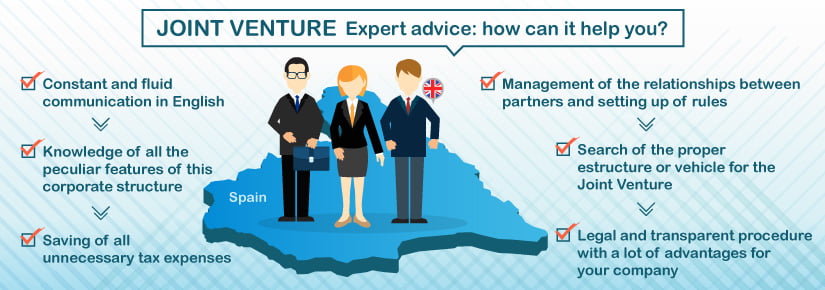
More and more Spanish and foreign companies are turning to joint ventures as a way to grow, innovate, or internationalize without assuming all the risk. It is a form of business collaboration that combines resources, knowledge, and efforts to achieve a common goal without losing independence. But how do they really work, and when is it a good idea to create one? In this article, we explain it with practical examples and legal key points.
What is a joint venture and what is it for?
Index of contents
A joint venture is an agreement between two or more companies that decide to temporarily join forces to develop a common project.
Each party contributes financial, technological, or human resources and shares both the benefits and risks of the operation.
Unlike a merger or acquisition, in a joint venture each company retains its legal identity and autonomy, even though there is operational and strategic coordination.
This model may be limited in duration (for example, to execute a specific project) or continue indefinitely if the collaboration proves profitable for both parties.
In practice, joint ventures are used to:
- Expanding into new international markets, especially when local regulations require a partner in the destination country.
- Developing new products or services by combining technology and know-how.
- Sharing financial or investment risks in highly competitive sectors.
- Accessing distribution channels or complementary resources that a single company does not have.
In Spain, joint ventures are based on the principle of freedom of contract set out in Article 1255 of the Civil Code, which allows each agreement to be tailored to the specific needs of the companies involved. In short, a joint venture is a strategic tool that combines forces without losing independence, allowing companies to grow faster, diversify their activities, or internationalize their business with less risk.
Main characteristics of a joint venture
A joint venture is formalized through a business collaboration agreement, in which two or more companies agree to pool their resources to carry out a common activity, without losing their legal independence.
It is not a merger or an ordinary commercial company, but rather a temporary and strategic alliance based on trust, a balance of contributions, and a clear definition of rights and obligations.
Legally, its structure is based on the principles of freedom of contract in the Civil Code and usually includes:
- Purpose and duration of the agreement: specifies the common project or goal and its period of validity.
- Contributions of each party: capital, technology, personnel, or material resources.
- Profit and loss regime: details how results are distributed or risks are assumed.
- Governance and control: establishes the decision-making bodies and conflict resolution mechanisms.
- Confidentiality and exit clauses: essential for protecting information and allowing for the orderly disengagement of partners.
Types of Joint Ventures
There are different ways to structure a joint venture, depending on the degree of legal integration between the companies and the objectives pursued.
In practice, there are two main types: contractual joint ventures and corporate or co-investment joint ventures.
According to legal form
A contractual joint venture is basically based on a legal agreement between the participating companies, while a corporate joint venture creates a new legal entity to carry out the project.
Contractual joint venture
This is the simplest and most flexible form. Companies collaborate through a private commercial contract, without creating a new legal entity.
Each party retains its full independence, and the agreement regulates aspects such as contributions, rights, profit distribution, and the duration of the project.
This model is common in commercial alliances, R&D projects, or one-off collaborations where a permanent structure is not required.
Corporate or joint venture partnership
In this case, the companies decide to set up a new company (for example, a limited liability company or a corporation) in which they participate as partners.
This new entity has its own legal personality, independent assets, and a defined governance structure.
It is often used for large-scale projects or international expansion, where stable management and greater legal certainty are required.
The agreement is formalized through a partnership agreement, which regulates decision-making, share distribution, and exit mechanisms.
According to the business objective
Beyond its legal form, a joint venture can be classified according to the purpose of the project:
- Innovation or R&D: to jointly develop technology or new products.
- Internationalization: to access foreign markets, especially where a local partner is required.
- Investment or expansion: to share costs and risks in new lines of business.
In all cases, success depends on the clarity of the contract and specialized legal and tax advice that guarantees the security and transparency of the alliance.
Examples of successful joint ventures
Joint ventures have been one of the most widely used formulas for companies to grow, innovate, or access new markets while sharing risks.
Below are some real-life cases that illustrate their strategic potential.
Sony – Ericsson (2001)
One of the best-known examples was the alliance between Sony Corporation and Ericsson AB.
The two companies formed a joint venture to combine Sony’s technological expertise in consumer electronics with Ericsson’s leadership in telecommunications.
The result was the Sony Ericsson brand, which dominated the mobile phone market for more than a decade before the advent of smartphones.
It was a clear example of how two complementary companies can create joint value through innovation without losing their identity.
Iberdrola – Masdar (Renewable Energy, 2023)
In Spain, Iberdrola and the Emirati company Masdar signed a joint venture in 2023 valued at more than €15 billion to develop offshore wind energy projects.
The agreement combines the technical and financial expertise of both companies to drive the global energy transition, reinforcing Spain’s position as a leader in clean energy.

Advantages and disadvantages of a joint venture
Before setting up a joint venture, it is essential to understand its benefits and the potential risks involved.
Although it is an effective tool for business cooperation, its success depends on proper planning and a balanced legal framework between the parties.
| Advantages | Disadvantages |
|---|---|
| Access to new markets and customers | Legal and tax complexity |
| Risk and cost reduction | Cultural or management differences |
| Joint innovation and development | Risk of conflicts in decision-making |
| No loss of legal independence | Limited duration |
| Strategic synergies | Leakage of sensitive knowledge or information |
How to create a joint venture step by step
Forming a joint venture requires strategic planning and a solid legal foundation. Here are the essential steps to do it correctly:
- Define the common goal. Identify the purpose of the agreement (expansion, innovation, joint investment, etc.) and the expected results.
- Select the right partner. Look for a company with complementary resources, values, and experience, and perform due diligence beforehand.
- Choose the legal form. Decide between a contractual joint venture (without a new company) or a corporate/co-investment joint venture (creating a separate entity).
- Draft the agreement or partnership agreement. Specify contributions, profit sharing, duration, control bodies, and confidentiality and exit clauses.
- Formalize and execute the agreement. Sign before a notary or with commercial validity, register the new company if applicable, and establish a joint monitoring and control system.
Legal aspects of a joint venture in Spain
Joint ventures are not specifically regulated under Spanish law, so they are governed by the freedom of contract principle set out in Article 1255 of the Civil Code and, where applicable, by the Capital Companies Act, if a joint company is formed.
From a legal standpoint, the contract must clearly state:
- The purpose of the agreement and its duration.
- The contributions and responsibilities of each party.
- The distribution of profits and losses, as well as the mechanisms for conflict resolution.
- Confidentiality, intellectual property, and exit clauses.
Tax aspects of a joint venture
In terms of taxation, the profits obtained by each partner are taxed in their own accounts, according to their participation or contribution to the project.
If a new company is created, it will have its own tax obligations (corporate income tax, VAT, withholdings, etc.).
When a joint venture is appropriate and when it is not
A joint venture can be an excellent tool for driving growth or accessing new markets, but it is not always the right formula. Its success depends on common goals, trust between the parties, and the correct legal structuring of the agreement.
It is advisable to create a joint venture when two or more companies wish to collaborate to internationalize, share investment and risks, or combine complementary resources and knowledge. It is also a good option for innovation or technological development projects, where cooperation accelerates results without losing legal independence.
On the other hand, it is not recommended when the partners have different objectives, seek total control, or the project can be resolved through simpler commercial contracts, such as distribution or franchising. In addition, its legal and tax complexity requires planning and expert advice.
How Leialta can help you create a joint venture
At LEIALTA, we support companies throughout the entire process of creating and managing a joint venture, from the initial strategic analysis to the drafting of the agreement and its correct legal and tax implementation.
Our team of advisors and lawyers, who are experts in commercial, tax, and corporate law, ensure that each alliance is formalized with legal certainty, balance between the parties, and regulatory compliance.
In addition, we help you to:
- Assess the feasibility and legal risks of the collaboration.
- Draft contracts and partnership agreements tailored to each project.
- Optimize the taxation and labor obligations arising from the agreement.
- Assist you in setting up the new company, if the project requires it.
Download our Guide to “How to set up a company in Spain” or the Guide to Guide: Employment Obligations for Companies in Spain to find out all the steps and legal requirements before formalizing your business alliance.



